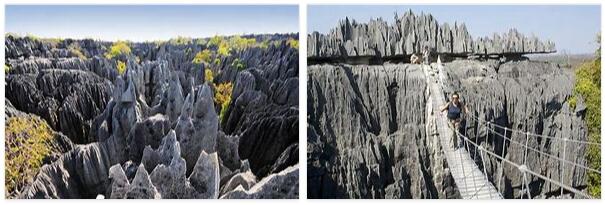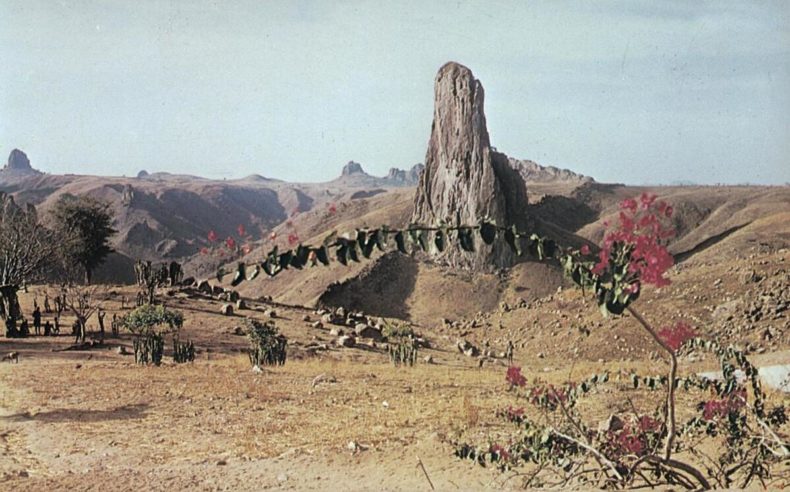The island of Madagascar is the largest in the world after Greenland, New Guinea and Borneo, with an area of 590,000 sq km. equal to that of France, Belgium and Holland combined: its maximum length, between the Amber Cape and the S. Maria Cape, is 1580 km., its average width is 450 km. It is divided into three regions, distinguished at the same time by their mountain systems, their geological constitution and their climate and which consequently present great differences in the fauna, flora and way of life of the residents. These three main regions are: the massif or central plateau; the eastern coastal range; and the more or less rugged great plains of the west and south.
According to NEXTICLE, the center of Madagascar, or central plateau as it is usually called, is occupied by a chaotic mass of mountains that covers about a quarter of the island, including the regions called Imerina and Betsileo. The average altitude of the plateau is 1200 m.; in the center of the island, in the country of Imerina, rises the massif of the Ankaratra mountains (Tsiafajavona, 2644 m.; Anhagitra, 2635), which however does not mark the maximum height of Madagascar, touched instead further north in the Tsaratanana mountains, which approach 3000 m. The central plateau is made up of hard rocks, both sedimentary and eruptive, crystalline schists, gneiss, granite, whose decomposition gives rise to a reddish or yellowish clayey earth that partially covers the soil, making it very sterile. because the roots of plants cannot penetrate them and do not find there the fertilizing elements they need. As for the climate, the winds, which crossing the Indian Ocean are saturated with water vapor, encountering the eastern coastal chain discharge much of their humidity on it: while the eastern side of the island is characterized by very abundant rainfall in every season, in the central plateau two seasons alternate, one dry and the other rainy, the latter corresponding to the hot season (overall rainfall remains below 1300 mm. per year). Therefore, those who leave the east coast to reach the inland plateau see the rugged and desolate landscape of the center of the island succeed the lush forests of the coastal chain. But if the soil in this region is generally of poor quality from an agronomic point of view, and if the crops can thrive only in wet slums or irrigated by streams, the climate is still good there because the excessive temperatures are unknown to you.: it is therefore that the central plateau is the most populated region of the island, the one where Malay immigrants took refuge fleeing the unhealthy coasts of the east, the one where large centers such as Tananarivo (Antananarivo, v.) could develop. Fianarantsoa, the one where Europeans can better live and work. Hydrographically, the central plateau belongs almost entirely to the slope of the Mozambique Channel: the rivers, after having crossed, forming waterfalls, the rocky threshold of the edge of the plateau, they spread out into large riverbeds cluttered with sand banks throughout the plains of the west. At the western limit of the plateau, on the parallel of Tananarivo, there is a well-known and very picturesque lake, located in a volcanic region and in fact surrounded by ancient craters: Lake Itasy, populated by water birds and also by crocodiles, is the center of a very rich region. At Antsirabe there is another lake, that of Tritiva, which occupies an ancient crater, and is one of the most beautiful examples of this type of lake. In the lowlands, and wherever there is water, the natives grow rice; in the southern part (Betsileo) potatoes are also grown, introduced by the Europeans and highly appreciated by the natives, and some fruits (especially mangoes).
The long coastal chain that separates the central plateau from the Indian Ocean forms the second region of Madagascar; of the total width of the island it occupies only one fifth, or about 80 kilometers, while the plains of the west occupy almost two fifths, and the central plateau the other two fifths. This coastal chain oriented by the NNE. it. it originates very close to the sea and rises by successive steps up to its crest, which has an average altitude from 1000 to 1500 m.; in the S. of the island the Andringitra mountains exceed 2500 m.: Joaindra, 2629 m .; Boby, 2660 m. A more or less wide sandy coastal strip is succeeded by hills from 20 to 50-100 m high. and more, generally covered by a characteristic vegetation composed of Ravenala or traveller’s trees, so called for the help they offer to the thirsty traveler, large plants with large leaves arranged in a fan shape on the top of the trunk, which, over the years, can reach several meters in height; by Vacoa or pandani and raffia, palm groves with elegant plumes, whose leaves provide the fibers with which the nets are woven; beyond begins the mountain proper. On the whole eastern side there are numerous woods which were even more extensive in the past, before the natives had set fire to large expanses of them; high up, under the crest of the mountains, the magnificent strip of forests stretches along the whole island from N. to S., praised, not without reason, by all travelers, which partly forms the fame of Madagascar. Indeed, few spectacles are as impressive as those offered by this vast tree-covered area whose peaks form at 25-30m. high a vault often impenetrable to the rays of the sun and where the most agile monkeys jump and the most splendid birds fly.



